Turning inserts in CNC machining – markings, types, and practical applications
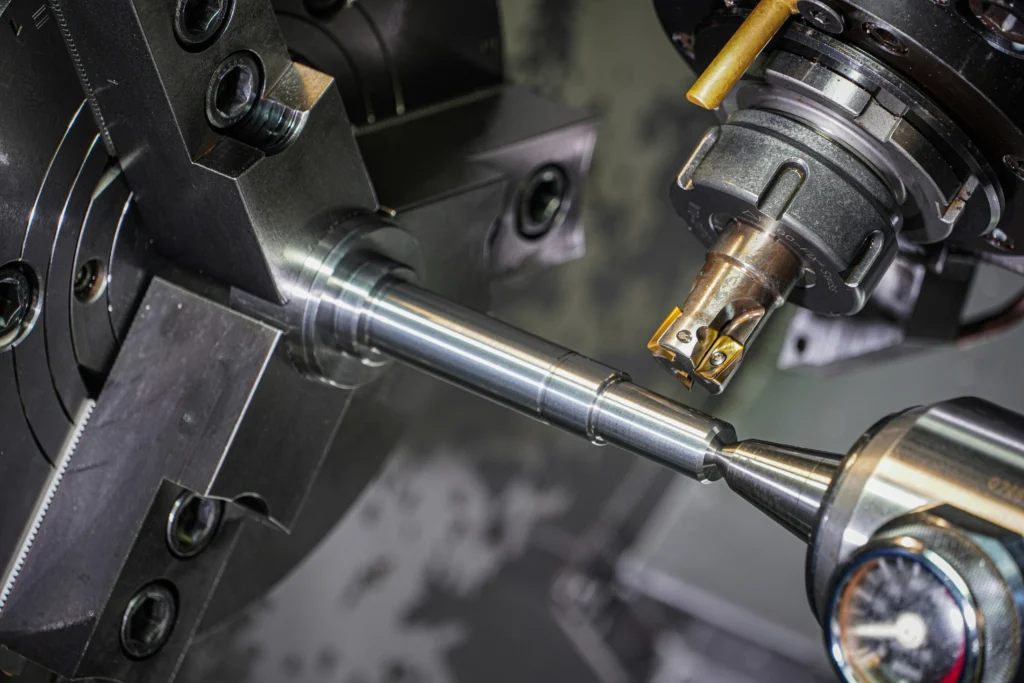
Turning inserts are one of the key elements of the CNC machining process. Their selection determines: process stability, tool durability, surface quality, and the ability to maintain the required tolerances. Manufacturers place information about the material application and recommended cutting parameters on the packaging of the inserts (usually packed in sets of several pieces). The correct interpretation of these markings is the foundation of proper technology. In this article, we discuss inserts used on lathes: for rough turning, finishing, threading, grooving, and cutting. First, we would like to emphasize that it is always worth verifying the detailed catalog data with the tool manufacturers. Material designations for inserts – groups P, M, K, N, S, H Manufacturers of turning inserts classify materials according to a standardized system: Each insert grade has a specific carbide composition, coating type, and geometry adapted to a given group. For example, inserts for stainless steel (M) are designed for ductile materials prone to build-up, while grades S and H must withstand high temperatures and intense abrasive wear. One geometry, different materials – where are the limits? In production practice, a single insert shape can be manufactured in different grades, intended for different materials. Compromise solutions are often used: It is therefore crucial to make a distinction – the geometry (shape of the insert) may be the same, but the grade must be selected according to the material being machined and the machining conditions. Inserts for rough turning Rough turning requires inserts with high edge strength and the ability to work with higher feed rates. This group includes WNMG, CNMG, and DNMG, among others. WNMG Inserts used in MWLNL/R holders are most often available with corner radii of 0.4 / 0.8 / 1.2 mm. In practice, a radius of 0.8 mm is most commonly used, less often 1.2 mm. A typical size is, for example, 0804. The tool is the basic solution for rough turning of small and medium-sized workpieces. CNMG DCLNL/R holders are designed for larger workpieces. They use inserts in sizes 12 and 16, with radii as for WNMG. The design provides greater rigidity of the system at larger diameters and lengths. DNMG DNMG inserts (e.g., 1506) with radii of 0.4 and 0.8 mm are the classic solution for rough and semi-rough machining in a wide range of materials. They combine good strength with the ability to shape contours. Inserts for finishing Finishing requires inserts with smaller corner radii and stable, predictable performance in order to achieve the target dimensions and roughness. DCMT Inserts available in small and large versions, with radii of 0.2 / 0.4 / 0.8 mm (0.8 – in larger variants). Used for semi-finishing and finishing passes. TNMG Finishing inserts with radii of 0.2 / 0.4 / 0.8 mm. Used to “guide” the dimension within tolerance. After each insert replacement, it is necessary to check the dimension (e.g., with a transameter) and, if necessary, correct the tool in the control system. CCMT rhombic inserts Available in small and large versions with radii of 0.2 / 0.4 / 0.8 mm. Used for finishing cylindrical and end surfaces as well as contours, especially in areas with limited access. VBMT Inserts with a similar application to TNMG. Four-edged (0.4 / 0.8 mm) and single-sided (0.2 / 0.4 / 0.8 mm) versions are available. Selected where the geometry of the SVJ holder provides better access to the machined surface. Thread cutting inserts Thread cutting inserts are divided into solutions for internal threads (IR/IL) and external threads (ER/EL), in trapezoidal, metric, inch, and other profiles. Inserts for grooves, channels, and cutting Channel cutters Cutters Inserts with widths from 0.5 to 3.0 mm, mainly used on bar lathes for cutting off workpieces. Practical application – a few rules In technological practice, the following rules can be adopted: Area of application Characteristics and selection rules Rough turning Used as basic tools for high-volume machining. The most commonly selected radius is 0.8/1.2 mm. The selection of the insert grade depends on the material and the required performance. Finishing turning Used to achieve the required dimensions and surface quality within the tolerance. After each insert replacement, it is necessary to check the dimensions and correct the settings if necessary. Thread turning The insert is selected individually based on the thread profile and the requirements of the drawing. There are no universal solutions — each geometry requires the right tool. Grooving and cutting The selection depends on the width and depth of the groove and the material of the workpiece. The selection of a turning insert should be based on both the manufacturer’s catalog data and the experience of the technology and production team. The combination of these two sources of knowledge allows for a stable, repeatable CNC machining process and optimal use of tools.
Precise hole machining in CNC machining – drilling, reaming, and boring in practice
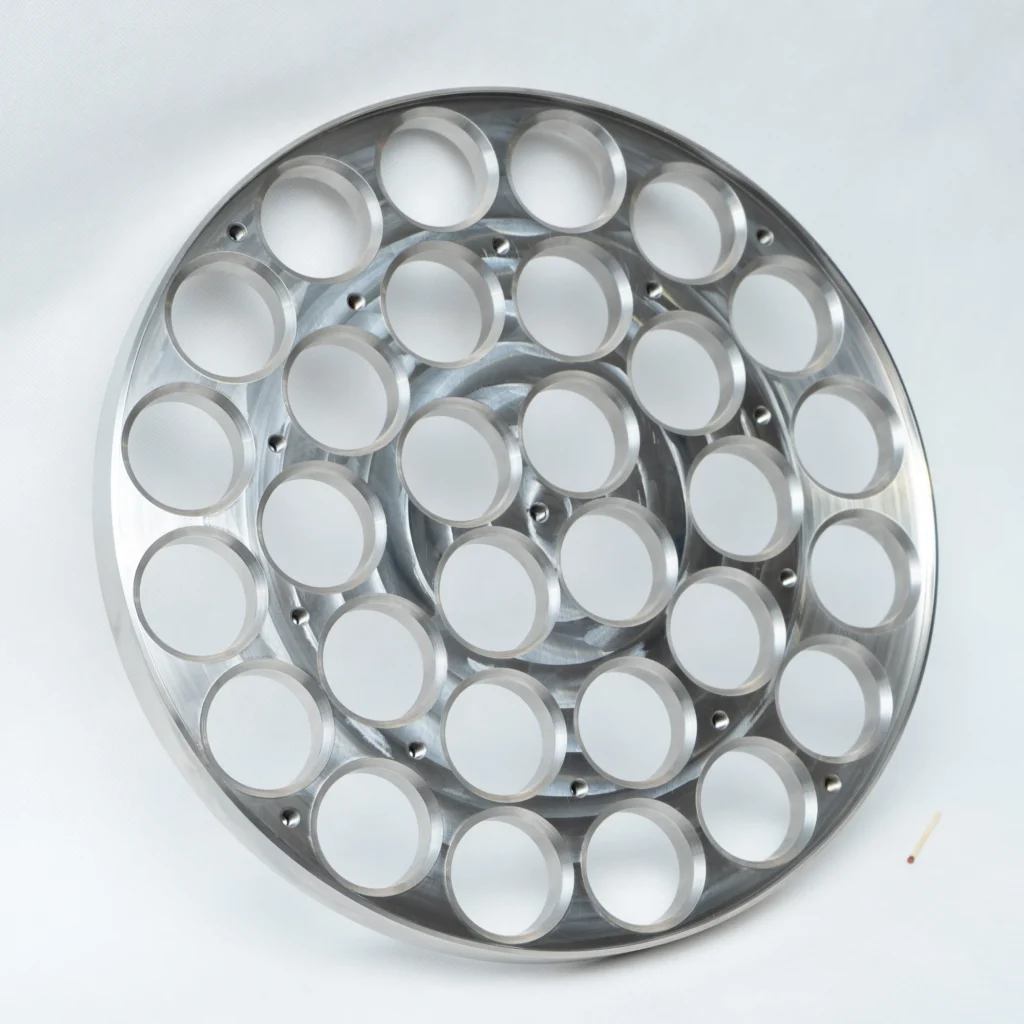
In CNC machining, one of the areas that requires very high repeatability and control is hole making operations. These are processes that combine requirements for dimensional accuracy, tool stability, and proper planning of the sequence of operations. Only their correct combination allows you to obtain a hole with parameters consistent with the design assumptions. At SIM Gdynia, we perform hole machining in steel, cast iron, and aluminum alloys on a daily basis, both in prototypes and in series production. Each of these materials requires a different approach, and the choice between drilling, reaming, and boring always depends on the specifics of the part and the expected accuracy. In the rest of this article, we discuss how the CNC hole machining process is planned and carried out in practice, and what techniques we use to maintain the required dimensions, axiality, and surface quality. Why are holes so critical in CNC machining? Holes are the element that transfers the function from the design to the actual part. In typical machine components, they are used for: This is why CNC machining of holes rarely ends with drilling alone. Drilling, reaming, boring – what is each responsible for? In simple terms, we can say that: Drilling provides sufficient accuracy for most mounting holes. When precise fits are required, the process is extended with additional steps: after drilling, the hole is reamed to correct the direction, and the final dimension is achieved by boring. Reaming is particularly important where several holes must maintain mutual geometry or where the hole serves a positioning function – it allows errors made during drilling to be removed and prepares the hole for accurate finishing. Reaming – a stable way to achieve accurate dimensions Effective reaming requires leaving the correct allowance after drilling. Too little allowance prevents cutting, and too much causes vibration and deterioration of surface quality. The correct value depends on the diameter and material, so it is selected according to the tool manufacturer’s recommendations. The operating parameters of a reamer differ from those of a drill. The speed is lower and the feed rate is higher, which improves surface uniformity and process stability. For deep holes or difficult-to-machine materials, internally cooled reamers are used, which provide better heat dissipation and longer tool life. Boring – precise geometry correction Boring is used where drilling alone does not guarantee axiality or correct hole geometry. It allows the hole path to be corrected and prepared for further finishing. We use them, among other things, for bearing seats, axial holes, and systems where several holes must maintain a precise mutual position. Boring heads allow for precise diameter adjustment, which makes it easier to maintain tolerances even in more demanding applications. Fits and tolerances – how to combine ISO fits with the realities of CNC machining The ISO fit system with a hole base (e.g., H7, H8) is standard in the design of machine components. For diameters in the range of 10–50 mm, the H7 tolerance is usually several to a dozen micrometers – a level that cannot be achieved consistently by drilling alone. At SIM Gdynia, we apply a simple rule – if a hole has a critical fit, we plan an additional reaming or boring operation. This gives the designer the certainty that their fit will be reflected in the actual part, and us the certainty that the CNC machining process is stable and predictable. Summary Precise hole machining requires a well-planned sequence of operations and a conscious selection of tools. In practice, the most important factors are the quality of the first pass, geometry control at the boring stage, and the repeatability of dimensions achieved by reaming. We most often analyze: At SIM Gdynia, we combine these elements into a single coherent technological process, thanks to which we are able to maintain both the dimensions and geometry of the holes within the required tolerances – regardless of the material, series, or complexity of the component.
From documentation to stable production – the work of a technologist at SIM Gdynia
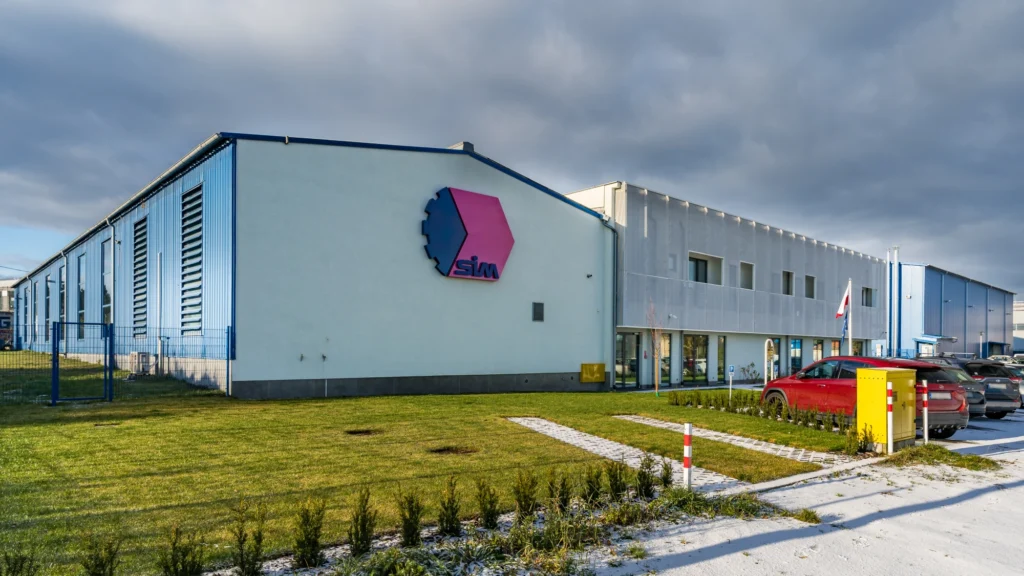
In modern CNC machining, there is a lot of talk about operators, setters, and quality control, but it is the technologist who is responsible for the foundation of the entire process. It is the technologist who defines how a part is to be made, selects the tools, determines the sequence of operations, and prepares the program that the machine will later execute. The repeatability, safety, and efficiency of production depend on the technologist’s decisions. At SIM Gdynia, the role of the technologist is clear: to translate the requirements from the customer’s drawing into a process that will be stable in series production, maintainable over time, and compliant with quality requirements. Below, we present how this works in practice, exactly as we do it every day. From inquiry to technology concept The process begins in the sales department, which receives an inquiry along with a technical drawing or 3D model of a new part. Before a feasibility statement is issued, the documentation is sent to the technologist. The technologist assesses whether the part can be manufactured under the specified production conditions. The technologist analyzes the material, tolerances, geometric requirements, and complexity of the part. They check the number of operations required, the availability of machines and tools, the need to purchase additional equipment, and the possibility of fitting within economically justified cycle times. On this basis, a preliminary technology concept is developed: the sequence of operations, the selection of machines, tools, and equipment, as well as the estimated processing time. This document is the basis for preparing a quote, which the sales representative presents to the customer as an offer to manufacture a new part. Operation plan – from the saw to the milling machine When the inquiry becomes a real order, the technologist prepares a detailed operation plan. At this stage, he determines how many steps will be involved in the production of the part and what machines will be used. At SIM Gdynia, we use an internal abbreviation to describe the sequence of processes, for example, P–T–T–C, where P stands for material preparation, T for turning, and C for milling. It is crucial to arrange the operations in such a way that the entire process is stable and economical. The technologist analyzes the machining bases, limits the number of retooling operations, and avoids unnecessary movement of the part between stations. Only after a logical and feasible plan has been established can we move on to the next stage, which is the preparation of programs for CNC machines. Programming and tool selection The preparation of CNC programs is one of the key stages of a technologist’s work. Based on the 3D model, technical documentation, and previously established technology, tool paths are created, along with the selection of feeds, rotational speeds, and machining strategies. The goal is to create a process that is stable, efficient, and repeatable in series. If the production of a part requires tools that are not part of the standard equipment, the technologist determines their specifications and orders their purchase. This applies to both special tools and the ongoing replenishment of the basic range of tools needed for production. This ensures that the machine has a complete set of equipment before a new order is placed. After preparing the programs, the technologist provides the planning department with information on the cycle time, type of tooling, and the specific machine on which the process should be carried out. On this basis, the part is entered into the schedule and sent for processing. Start of production – setup, control, stabilization When the part reaches the designated machine, the technologist enters the program and supervises the process setup. This stage includes the selection of bases, tool zeroing, and verification of compliance with the documentation. The first pieces are always treated as a trial stage, during which measurements are taken and minor adjustments are made. Setting up the first pieces The operator and technologist jointly observe the behavior of the tools, surface quality, and dimensional stability. If it is necessary to adjust the parameters or make minor changes to the trajectory, they are introduced at this stage. Transition to serial production Once the process is stable and the measurement results are repeatable, the order goes into serial mode. Nevertheless, the technologist remains on standby to provide support, as the machining conditions may need to be adjusted during the production of the batch. Tools – when standard clamping is not enough Many parts, especially forgings, castings, or irregularly shaped components, require individual clamping solutions. Standard vices or jaws will not provide stability or tool access, so it is necessary to prepare dedicated tooling. Tooling design At SIM Gdynia, a designated technologist is responsible for tooling design. Their task is to prepare the clamping so that: Machining on the tool Only after the tool has been made and checked is it possible to safely machine complex parts that cannot be clamped in the standard way. Drawing changes and technology updates During cooperation with customers, modifications to details often arise: changes in chamfers, diameters, tolerances, or additional features. Each such update requires a review of the entire technology. Technologist’s response to changes The technologist analyzes the new documentation, updates the CNC programs, and makes corrections to the process cards. Sometimes this takes a moment, and sometimes it requires a complete overhaul of the machining concept. The best versions of the programs At the same time, operators and foremen refine the programs on the machine, adapting them to the working conditions of a specific workstation. When the program achieves full stability and optimal cycle time, the technologist saves it as a reference version to maintain full repeatability in subsequent series. The technologist as a link between the office and the shop floor The role of the technologist combines engineering work with manufacturing practice. On the one hand, they analyze documentation, tolerances, and customer requirements, and on the other, they know the machines, tools, and real limitations of the process. A key function in the
Large-scale CNC machining – challenges, limitations, and best practices
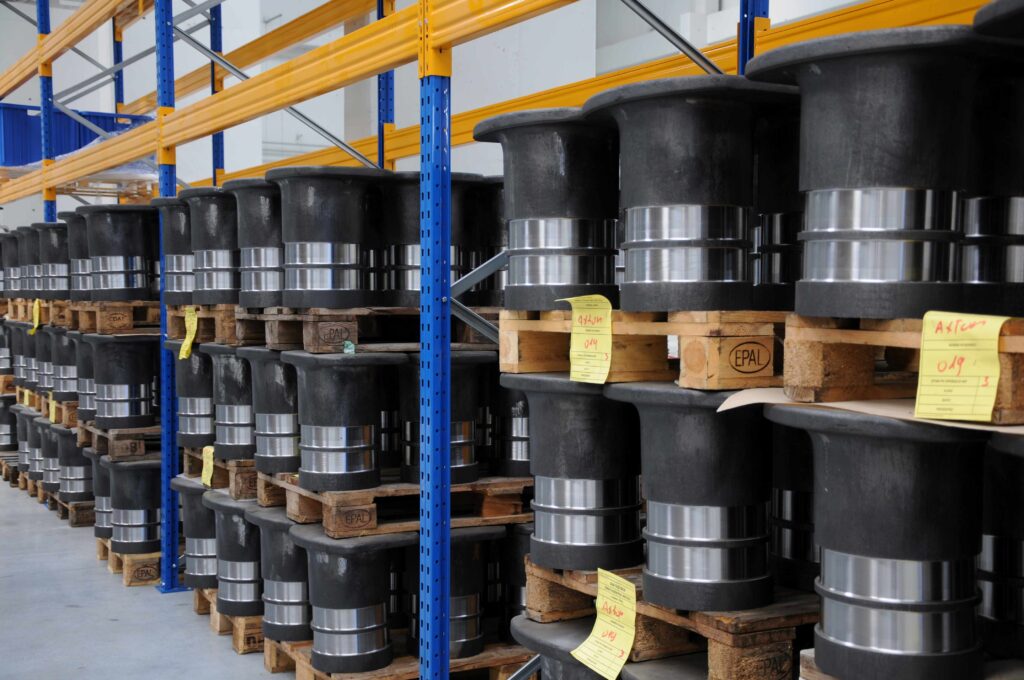
CNC machining of large-size components is a completely different category of challenges than working with typical, small parts. When a part weighs several dozen kilograms, is several meters long, and must maintain a tolerance of hundreds of micrometers, every mistake becomes costly—both in terms of material and machine downtime. Therefore, planning such a process requires a different approach than with typical small parts. At SIM Gdynia, we perform CNC machining of components weighing up to 500 kg for the machine, energy, defense, and automation industries. Based on our experience, below we summarize the most important challenges, limitations, and best practices that technologists and production engineers deal with on a daily basis. How exactly does large-scale CNC machining differ from standard machining? In practice, we usually refer to “large dimensions” when: Such parts include, for example, machine bodies, base plates, welded frames, gear housings, and large-diameter bearing elements. In their case, CNC machining must reconcile high accuracy with the limitations of the working area, lifting capacity, and rigidity of the entire system. Added to this are logistics, more specifically the transfer of the workpiece by crane, the selection of suspension points, and the organization of the space around the machine so that loading and unloading are safe and repeatable. Main technological challenges with large dimensions With large components, typical machining problems begin to “scale up.” What is a minor inconvenience with a small workpiece can be a make-or-break factor for an entire series with a plate several meters long. The key challenges can be grouped into several areas: Machine, workpiece, and material limitations – real hard limits Even the best machine park has objective geometric and dynamic limitations. In large-scale CNC machining, the following are particularly noticeable: Large dimensions often involve castings with allowances or welded structures. After rough machining, residual stresses are released, and deflections, twists, and local deformations appear. For this reason, the optimal process is usually divided into a roughing stage with a controlled allowance, followed by stress relief (thermal or “natural” – temporary) and a finishing stage focused on accuracy and surface quality. How to approach the planning of CNC machining of large-size parts? With large-size components, the effectiveness of machining largely depends on how the entire process is planned. Unlike small-size parts, here every technological assumption affects not only quality, but also work safety and geometric stability. Therefore, it is worth basing the preparation of the process on a few key steps. The first step is to evaluate the part in terms of tool availability, basing possibilities, and the sequence of operations. In practice, this means comparing the design assumptions with the actual limitations of the machines and tooling. Such an analysis allows you to establish reference points, predict the risk of deformation, and determine whether the part may require modular machining. Large parts require layered machining. First, a roughing stage is planned, the purpose of which is the controlled removal of excess material, and only after the part has stabilized is the finishing stage carried out. This division minimizes the impact of released stresses on the final dimensions and makes it easier to maintain overall tolerances. The choice of machine tool is not based solely on the size of the part, but also on its design and the distribution of machined surfaces. For some components, a horizontal center with a large axis range will be more effective, while for others, a boring machine will be more suitable. At this stage, the required tooling and workpiece support method are also determined. For large dimensions, CAM simulation is not only used for collision control. It allows you to assess how tools, holders, and the machine table will affect the possibility of smooth transitions and whether the machined surfaces are accessible without changing the bases. This makes the process more predictable, and the setup on the machine is faster and without the risk of unplanned downtime. Summary – large-scale CNC machining without surprises Large-scale machining is an area where small errors have big consequences. The key to predictability is: If you are working on a project that requires CNC machining of large components and are looking for a partner who will not only manufacture the part but also help you optimize the process, send us your technical drawing. We will be happy to analyze your requirements, propose the technology, and prepare an offer tailored to your application.
Aluminum bodies in military production – how the most demanding structural elements are made

The body is an element that rarely attracts attention, but without it, no system would function properly. It forms the structural base to which other parts are attached – from the smallest components to entire device modules. In military applications, the tightness, strength, and stability of the entire system depend on the precision of the body’s manufacture. At SIM Gdynia, we perform CNC machining and prepare bodies with complex geometries, which require not only high precision, but also experience and technological knowledge. Each of them is created based on an individual program, dedicated tooling, and a multi-stage dimensional control process. From raw material to finished component The production process begins with the preparation of the material and the development of the machining technology. We manufacture bodies from materials adapted to the design requirements – usually light metals that combine strength with low weight and good machinability. Each side of the body requires separate tool paths and mounting methods. The part is machined in stages, and after each operation, the flatness and parallelism of the reference surface are checked. In this type of component, it is not speed that counts, but repeatability and dimensional stability. An example of this is one of our bodies, visible in the photos in its characteristic golden color. You can see the hours of work that went into it – milled channels, sockets, and holes that must fit perfectly with the other components. Each of these elements requires a separate program, the right tool, and precise cooling during cutting. Body milling – precision takes time The milling of bodies is carried out on CNC machining centers, which allow for high accuracy and repeatability throughout the entire production cycle. Depending on the geometry of the part, we use both three-axis and five-axis centers – especially for machining slanted surfaces, undercuts, or sockets with limited access. Maintaining dimensional stability Bodies often have thin-walled structures and complex channels that react to internal stresses in the material. To maintain dimensional stability, the process is carried out in stages – with breaks for measurement and correction of deviations. It is not a matter of quickly removing excess material, but of controlled cutting that ensures geometry consistent with the design throughout the entire machining cycle. Individual detail – individual program Each body is a separate project: different geometry, different clamping system, different machining strategies. A separate CAM program is developed for each one, specifying the sequence of operations, speeds, depths, and tool paths. We use high-pressure cooling in the process to limit the impact of temperature and maintain surface quality in accordance with the documentation. After milling – subsequent machining stages After machining on CNC centers, the bodies are sent to the metalworking department, where they are cleaned, deburred, and visually inspected. At this stage, all cutting residues are removed – this is where the actual quality of workmanship is revealed: every channel, edge, and hole must be clean, smooth, and free of burrs. The next step is the finishing processes carried out in cooperation. Depending on the design, the body may undergo blackening, gilding, anodizing, or other surface treatments that increase its resistance to corrosion and environmental influences. In the case of military components, these coatings also have protective functions – they minimize light reflections and improve durability in field conditions. After returning from the cooperative, the details are re-verified and, if necessary, subjected to minor finishing or marking. Preparing the body for assembly The finished bodies are sent to the quality department, where they are checked and prepared for further assembly with the other components. The cleanliness of the surfaces, the fit of the holes and sockets, and dimensional compliance with the documentation are checked. At this stage, not only accuracy but also aesthetics are important. In many military projects, the body serves both a structural and a protective function, so the surfaces must be uniform, without tool marks or discoloration after processing. Depending on the specifics of the order, the body can be a stand-alone component or a base for further assembly of several subassemblies. We know from experience that the moment of transition from production to assembly is crucial – the subsequent fit and reliability of the entire system depends on the accuracy of the base surfaces. Why body production requires experience Body production is a process in which every detail requires an individual approach, and the final result is determined by the experience of operators, technologists, and quality controllers. The machine tool alone is not enough – it is necessary to know how the material reacts to machining, how stresses are distributed, and how to maintain dimensions after multiple operations. With over 45 years of experience in machining mechanical components, we know that the precision of the body is the result of a consistently conducted process, not a single operation. That is why each stage – from the first clamping on the milling machine to the final marking – is carried out under full dimensional and documentary supervision. Summary An aluminum body is much more than just a casing. It is a key structural element on which the functionality, reliability, and durability of the entire device depend. Its production requires accuracy, patience, and understanding of the material—as well as experience in working with parts with complex geometry and high quality requirements. At SIM Gdynia, we treat each body individually, with the same precision that a designer approaches the design. There is no room for compromise in military systems – that is why our processes focus not only on dimensions, but also on perfection in every detail.
SIM Gdynia on the podium of the 4th KS Chwaszczyno Partners and Friends Football Tournament
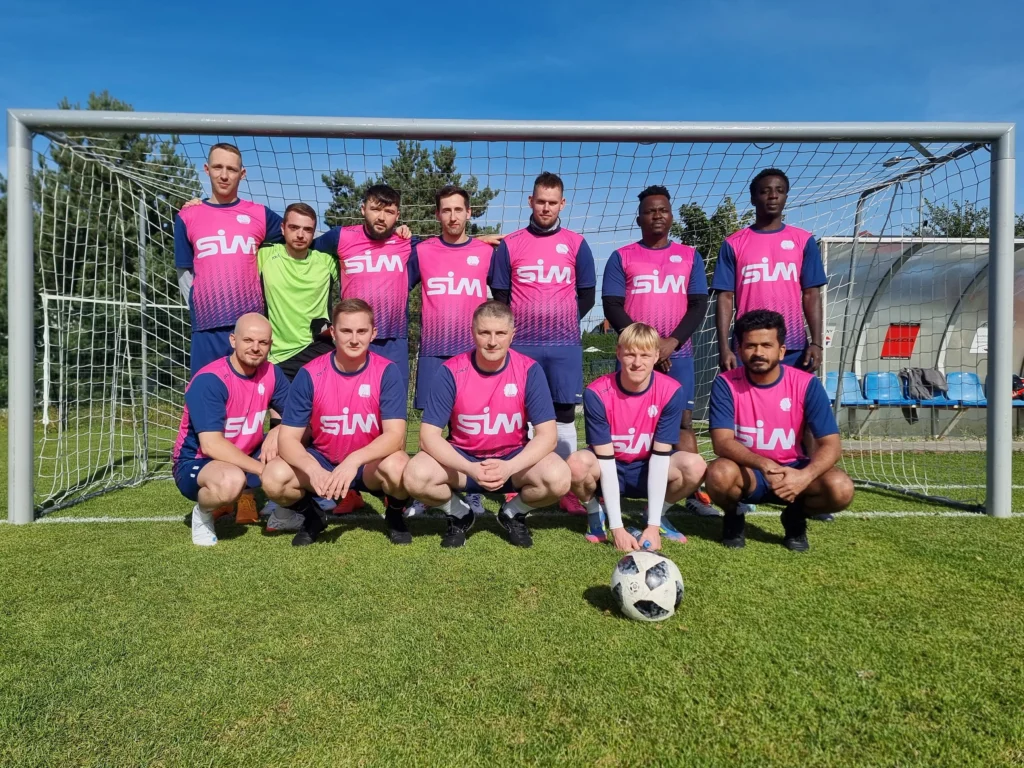
On Saturday, September 27, 2025, the Toyota Arena stadium in Chwaszczyno hosted the 4th KS Chwaszczyno Partners and Friends Football Tournament. The event, which has become a permanent fixture in the calendar of local sporting initiatives, once again combined competition, integration, and good fun in the spirit of sport. Shared passion and integration of local companies The tournament, organized by the Chwaszczyno Sports Club, is not only about sporting competition, but above all about integrating companies that support the club and the local community. Every year, companies from Pomerania that cooperate on a daily basis in various industries take part in the competition, and during the tournament they meet on the pitch as rivals—and partners at the same time. Six teams took part in this year’s edition: The matches were played in a round-robin system on two pitches, with each match lasting 17 minutes. After four hours of intense play, the winner of the tournament was determined. Second place for SIM Gdynia We are proud to announce that the SIM Gdynia team took second place in this year’s competition. Congratulations to our entire team for their commitment, sportsmanship, and great atmosphere on the field. You have shown that the strength of SIM Gdynia lies not only in precision manufacturing, but also in determination, cooperation, and team spirit. Thanks and invitation to the next edition We would like to thank the tournament organizers, all participants, and the fans who cheered on their teams. Special congratulations go to the winners – Triada Augusto Pomorze, who won the cup for the second time in the history of the competition. We are glad that we could be part of this event and are already looking forward to the next edition. We also encourage you to take a look at a few photos from the tournament, which capture the atmosphere of sporting competition and cooperation. Link: https://www.facebook.com/share/p/1A5QZwXTXj/?mibextid=wwXIfr
Mechanical assembly process at SIM Gdynia – precision for the defense industry

In defense manufacturing, repeatability and complete control over every stage of production are crucial. From the quality of CNC machining and surface preparation to final assembly, each step must be performed with consistent precision to ensure that the finished component fully meets the design requirements. One of the final stages is mechanical assembly, in which precisely machined parts form a complete assembly. It is at this point that the experience of the employees, good work organization, and effective quality control determine the final result. In the rest of this article, we show you what the mechanical assembly process looks like, which we have perfected at SIM Gdynia over more than 45 years of operation – from the preparation of details to the final verification of the finished component. From design to assembly – how the process works The process begins with an order for a complete assembly, in which each element is designed for a precise fit. The subassemblies are manufactured on our CNC machining centers – lathes, 4- and 5-axis milling machines, depending on the geometry and required tolerances. For components intended for defense applications, it is crucial to maintain dimensions and surface cleanliness, as they often operate in environments with increased requirements for tightness, vibration resistance, or heat resistance. Therefore, each stage of processing is carefully monitored and documented. After machining, the parts are sent to the metalworking department, where they are cleaned, deburred, and pre-verified. At this stage, burrs, sharp edges, and cooling emulsion residues are removed. Each part undergoes a visual inspection before moving on to the next stages of the process. Some components, especially those used in military systems, are then sent to external partners for blackening, anodizing, galvanizing, or other surface protection processes. Such coatings increase corrosion resistance and improve conductivity properties. After returning from finishing, the parts are recorded and sent for final assembly. Step–by–step mechanical assembly Each assembly has a designated person in charge – a technician who oversees the process from the moment the parts are received to the final quality control. This person supervises compliance with documentation, the sequence of operations, and the final result. Verification and preparation Before the actual assembly begins, all parts are thoroughly checked for dimensions, cleanliness, and completeness. The inspection is carried out in the presence of a quality control employee, who confirms that all details meet the drawing and surface requirements. At this stage, the assembler also prepares the necessary tools, torque wrenches, safety measures, and compiles a set of components for a given assembly. In the case of projects for the defense sector, particular attention is paid to the cleanliness of the assembly and the maintenance of connection parameters – even slight contamination or incorrect tightening can affect the operation of the system in the field. Assembling and securing connections Assembly is like a precise jigsaw puzzle, in which each component has its place and orientation. The fit requires accuracy down to hundredths and thousandths of a millimeter. Screw connections are tightened to a specified torque, and in places requiring a permanent bond, assembly adhesives or thread locks are used. In military designs, spacers, retaining sleeves, or threaded inserts are often used to increase the durability of connections in hard materials. Such solutions allow for trouble-free operation even under high dynamic loads. The installer’s task is not only to assemble the parts, but also to ensure that the entire assembly works smoothly, without play or jamming. The process involves quality control, which verifies the compliance of each step with the technical documentation. Each assembled element is checked for dimensions, tightening torques, and overall appearance—no part may show signs of impact or scratches. Work organization and interdepartmental cooperation Depending on the complexity of the project, the assembler works with metalworkers who help prepare components or larger structures. Assembly teams remain flexible—their composition may change depending on the current production load. The entire process requires close interdepartmental coordination. CNC production is responsible for the accuracy of the components, the metalworking shop for their preparation, cooperation for the quality of the coatings, and assembly for the final fit and completeness. All activities are recorded in the system, which ensures full traceability of each element – from the material to the finished assembly. Securing and shipping finished components After assembly, each assembly is cleaned and properly secured. The components are placed in special compartments or technical foams that protect them from dents and scratches during transport. Then, the complete sets are packed, labeled, and transferred to the warehouse or directly to shipping, depending on the arrangements with the customer. Finally, the assembler and quality control prepare inspection documentation confirming dimensional compliance, assembly quality, and surface condition. In the case of projects for the defense sector, this document forms the basis for issuing a quality certificate, which is necessary for deliveries to military systems. Summary Mechanical assembly is not only the final stage of production, but a process that requires precision, cleanliness, and responsibility at every level. From dimensional control to final packaging, every step matters. At SIM Gdynia, assembly is carried out by dedicated personnel who are responsible for the entire process and cooperate with the locksmith and quality control departments. This approach allows us to maintain the highest standards required in defense industry projects and ensure that the finished components reach customers in full compliance with the documentation—ready to work in systems where reliability is as important as precision.
SIM Gdynia recognized by Forbes again – ranked among the best family businesses in Pomerania for the second time in a row
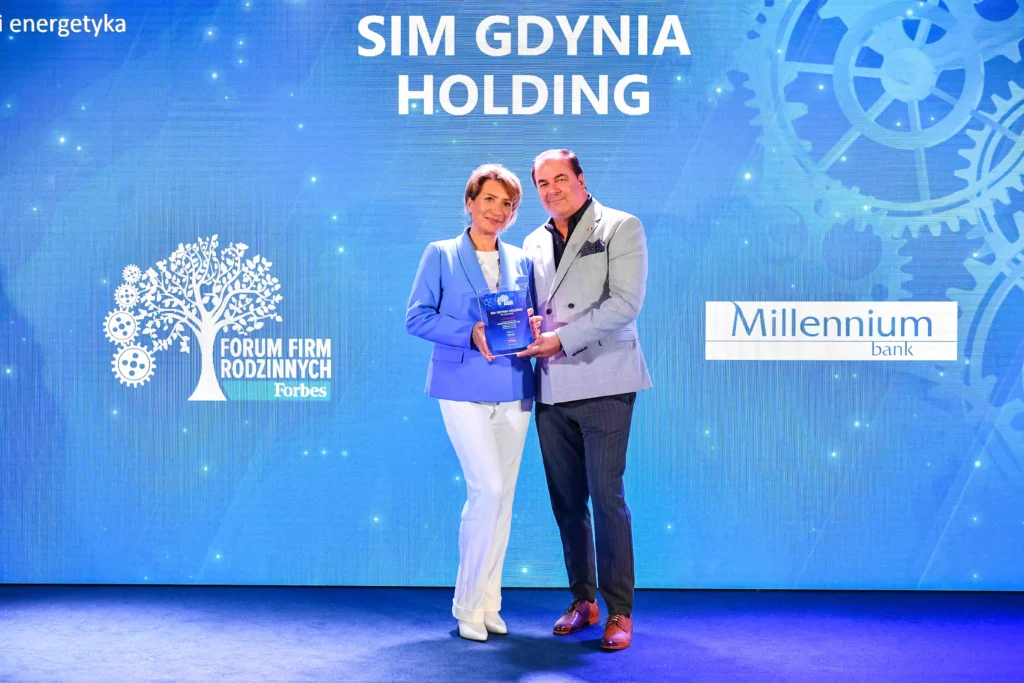
We are proud to announce that SIM Gdynia has been recognized for the second time in a row in the prestigious Forbes 2025 Family Business Forum ranking. Our company was among the recognized family businesses in the Pomeranian Province in the category of revenues up to PLN 100 million. This is a special distinction for us, not only because it comes from one of the most renowned business magazines in the world, but above all because it confirms the stable development of SIM Gdynia and our unwavering consistency in the pursuit of excellence. What this distinction means The Forbes Family Business Forum ranking distinguishes companies that combine modern management with family values – trust, responsibility, and long-term thinking. For us at SIM Gdynia, this is special proof that the direction we have taken is the right one. The fact that we have been among the distinguished companies for the second time in a row confirms that our actions bring lasting results and that the way we combine tradition with technology is recognized and appreciated on the market. For over 45 years, we have been consistently investing in modern CNC machining technologies, the development of engineering teams, and the improvement of production processes. Every detail that leaves our plant is the result of the cooperation of people for whom precision is not only a technical requirement, but part of our company’s DNA. Family tradition meets Industry 4.0 The history of SIM Gdynia began in 1978 with a small locksmith’s workshop. Today, we are a modern company serving customers in industries such as: Our strength lies in combining a family character with advanced technology. Thanks to over 100 CNC machines from renowned manufacturers such as Makino and Okuma, we can carry out projects that require the highest precision. Success we build together This distinction would not have been possible without our team of experienced engineers, CNC operators, technologists, and quality specialists. It is also thanks to our customers and partners, who have been entrusting us with their most demanding projects for years. Thank you for your trust and cooperation. It is thanks to you that we can continue to grow, innovate, and maintain the highest production standards. An award that motivates The Forbes 2025 award is not only a source of pride for us – it is also a commitment. At SIM Gdynia, we will continue to invest in: Summary The second consecutive Forbes Family Business Forum title confirms that family character, technological precision, and consistency in action create a solid foundation for success. At SIM Gdynia, we believe that modern CNC machining is not just a technology—it is a philosophy of continuous improvement. We would like to thank Forbes Polska for this distinction and our partners for their continued trust. Together, we are creating the future of precision manufacturing.
CNC machining in prototyping and short-run production for the military

In the defense industry, response time and flexibility are as important as reliability. In a world where military technology is developing rapidly and requirements change from month to month, the traditional mass production model does not always work. This is where CNC prototyping for the military and short–run production play a huge role. CNC machining makes it possible not only to quickly develop prototypes of new components, but also to produce short test series that go directly to the testing ground. In the defense sector, this is not a luxury, but a necessity – because this is the only way to meet the demands of the modern battlefield. The role of CNC prototyping in the defense sector CNC prototyping allows engineers and designers to instantly translate a concept into an actual component. The process is as follows: Design → CAD model → CNC program → physical prototype → testing → revisions. This dynamically shortens the development cycle. In the military, this is crucial. The prototype can be quickly tested under field conditions, corrections can be made, and the prototype can be put into production in a short period of time. It is also worth mentioning the Iterative “Test-Analyze-Fix-Test” approach which is now a standard in the defense industry, and CNC machining makes it possible to implement it effectively. Read more about CNC machining in our article ‘‘What is CNC machining?’’ CNC prototyping support technologies for the military Prototyping is not only about speed, but also precision. The most advanced CNC technologies are used to accomplish such tasks: Thanks to such technologies, military prototypes are not just “preview versions” – they are fully functional components ready for testing. CNC short runs in defense – when are they needed? Short-run production in the military is as important as prototyping itself. It enables rapid implementation of solutions that are in the testing phase or need to be upgraded. Typical applications of CNC short runs in defense: Each batch must meet the same quality standards as mass production, and documentation includes material certificates, process reports and full traceability. Process – from prototype to short run 1. Preparation The 3D design (CAD) is transformed into a CNC program (G/M code), tailored to the specific machine. 2 Prototyping 3 Approval of the pattern The first piece undergoes First Article Inspection (FAI) – a comprehensive dimensional and quality inspection. 4 Short run Production of repetitive parts while maintaining full documentation. Each step is monitored and processes are reported. 5. quality control Sources of restrictive standards in CNC machining for defense The production of defense components differs from the civilian industry primarily in terms of tolerances and quality control. In commercial applications, tolerances of 0.01 mm are acceptable. In the military industry, requirements go as high as ±0.005 mm. The reason is simple: components must perform reliably in extreme conditions – from Arctic frost to desert heat to environments subjected to severe overloading and contact with aggressive chemicals. Therefore, the entire process must comply with international quality standards, such as ISO 9001, AS9100D and AQAP – the NATO quality assurance system. When working with foreign entities, ITAR or DFARS regulations may additionally apply, covering export control and data security. Learn more about CNC machining requirements in the defense and military sectors in our article: ‘‘CNC machining in the defense and military industry – what requirements must a supplier meet?’’. SIM Gdynia – experience in prototyping and short runs At SIM Gdynia, we support the defense and military sectors with precision CNC machining. We have more than 100 modern machines, including 5-axis centers, which allow us to realize both unit prototypes and short series with the highest quality requirements. Our experience includes working with the most demanding materials – titanium, Inconel or hardened steels. We carry out all processes in accordance with international quality standards. What ‘ s more, at SIM Gdynia on July 4, 2025, we obtained a license from the Ministry of Internal Affairs and Administration (No. B-090/2025), which allows us to carry out projects for the defense industry. The process of obtaining it is extremely restrictive and requires meeting standards both in terms of safety and CNC machining itself. Summary CNC prototyping for the military and short CNC series in defense are today the pillars of the army’s technological development. They enable rapid testing, iteration and implementation of new solutions. Restrictive standards, full documentation and the highest precision are necessary – because in the defense sector the margin for error does not exist. At SIM Gdynia, we provide comprehensive support – from prototype to short series – in full compliance with the requirements of the military industry. Feel free to contact us.
News report on the SIM Gdynia production team integration trip

In September, we organized an integration and development trip for teams directly involved in production. It was attended by representatives of the technology department, sales department and foremen. We believe that it is the team that is the foundation of our company. Therefore, working together on improvements and building relationships between departments are of great value to us. The first part was dedicated to integration. Through team games, group tasks and discussions, we were able to build greater mutual understanding and get away from the daily production routine. The second part had a workshop character. The training was led by Piotr Olewniczak from RID. Together we analyzed the challenges we face every day in production. We talked about possible improvements that can realistically affect the efficiency of our processes. Many valuable ideas were raised. Some of them we are already analyzing for implementation. For us, as SIM Gdynia, such meetings are not only a form of integration, but above all an important element of building a company based on cooperation and open communication. We believe that it is through this approach that we can continuously develop and effectively respond to production challenges. The organizational culture that we create together with our team is a real support for us in our daily work and a source of advantage in the market of CNC machining services. Thanks to all participants for their openness and activity!
